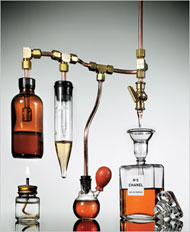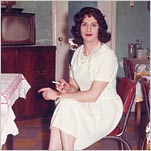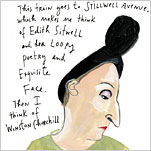It isn’t even the norm. I was in an extremely elegant bastion of perfume recently — gorgeous and innovative, with surprising scents — when I complimented a woman buying Chanel No. 5 on her choice. And she said, “Yes, I buy Chanel scents because they’re made from 100 percent natural products.”
Huh?
There is an almost universal misunderstanding about perfume. The fact of the matter is that not only do all Chanel perfumes contain synthetic molecules, but also every great scent, from Armani to Gaultier to Lauren, is built on them.
The secret of Dior’s Eau Sauvage, by the legendary perfumer Edmond Roudnitska, is a synthetic called methyl dihydrojasmonate, a molecule that smells beautifully of clean, pure light, almost as if it were water you were smelling. The heart of the 1912 cult favorite Quelques Fleurs by Houbigant is a synthetic called hydroxycitronellal. CK One’s engine runs on Dihydromercenol. Angel’s secret is the molecule ethyl maltol (which was isolated in 1969 and is the succulent sweet molecule you smell when you smell cotton candy). And the secret of Chanel No. 5? Molecules called aldehydes, first synthesized in a laboratory in France in 1903.
Prejudice against synthetics is like any other prejudice. There’s the entry-level misperception: “Natural materials are always good.” Wrong. A low-quality natural narcissus is going to smell like garbage, while a good synthetic heliotropin is an olfactory marvel, as if a tonka bean had somehow been crossed with a cloud. Second misperception: “Synthetics are cheap.” Are you kidding? The best synthetics, like the best natural ingredients, are extremely expensive. One terrific synthetic called Amberiff costs more than $1,200 a pound.
Then there’s the slightly more sophisticated level of ignorance: “A synthetic is more likely to cause an allergic reaction.” Wrong again. A natural is more apt to do that. Take Sandalore, a synthetic molecule that smells like sandalwood. It’s exactly one molecule: C14H26O. Use Sandalore to get your sandalwood note, and there will be only one possibility of an allergic reaction. Use a natural sandalwood, which contains hundreds of molecules — alpha- and beta-Santalol, Spirosantalol, beta-Curcumene, (Z)-Nucifero, etc. — and you’ve got hundreds of different possible allergic reactions. Moreover, synthetic sandalwoods are ecofriendly. The sandalwood forests of India are being destroyed at a terrible rate, and the price of natural sandalwood is skyrocketing (currently heading up to $800 a pound). One perfumer I know told me that because of this, he now refuses to use natural materials in perfumes.
“Synthetics are ‘modern’ and ‘American,’ and naturals are ‘French.”’ Completely wrong. There’s no French-er house than Guerlain, no more classic collection of perfumes, and Guerlain perfumers began the synthetics revolution in 1889 by pouring three synthetics into the soul of its great perfume Jicky. The classic L’Heure Bleue (1912) derives its beauty from methyl anthranilate; Mitsouko (1919) uses the very elegant synthetic aldehyde C-14 (which smells deliciously of delicate, ripe peach); and the immortal Shalimar (1925) has, among other synthetics, ethylvanillin and quinolines. The sleek and, in my view, underrated Samsara has Sandalore, and just a few years ago the perfumer Maurice Roucel put a really cool molecule — cis-3 hexenyl (it smells, by itself, of freshly cut grass) — into his modern classic L’Instant de Guerlain.
As all perfumers know, synthetics are the essence of modern perfume. Creating a perfume without them is like painting a picture without blues or reds. You could do it, but why? Synthetics give you range, from the amazing milky molecule lactone, which makes Gucci’s Rush the ingenious piece of abstract art that it is, to the gorgeous synthetic iris that the perfumer Olivier Polge created when he made Dior Homme. (It’s impossible for technical reasons to wring any scent from the flower.)
Synthetics are the stock in trade of many companies, but I was talking with Françoise Donche, the creative director of fragrance for Parfums Givenchy, about the sublime scents made by Firmenich, a Swiss materials company. “Firmenich,” Françoise cooed, “c’est la haute couture de la molécule!” And it is. It was Firmenich that introduced Mitsouko’s aldehyde C-14 to Guerlain in 1919, and in 2006 the company is giving perfumers — and us — some of the most wonderful new scents around.
Just one example: the Firmenich perfumer Olivier Cresp was on his way to fast becoming one of his company’s most valuable players when he created Black XS for Paco Rabanne and shot to Tiger Woods status. Black XS is elegant, refined and contemporary, an unplaceable scent, at once warming and cooling, and instantly mesmerizing, like a compulsively listenable rock album. Cresp used three terrific synthetics: the amazing Norlimbanol, which gives you the hypnotic smell of absolute desiccation (imagine the scent of total dryness); Z11, an utterly lovely dry wood scent; and Muscenone, an expensive synthetic musk that is creamy, voluptuous, powdery and amazingly deep — it builds and builds.
Sure, some synthetics I hate. Top of my hit list: Dihydromercenol. To me, it smells like laundry detergent spilled on an aluminum counter. It exploded on the scene in 1982 in Drakkar Noir (at a jaw-dropping 10 percent of the formula), followed by Polo, Cool Water and CK One, where it worked nicely. But now that it’s been put in eight million masculine fragrances, it’s a boring cliché. But I hate natural lavender, too, for the same reason: natural or synthetic, a cliché is a cliché.
In the end, it comes down to this: There is a hugely successful perfume on the market. You know it. You may well be wearing it.
It doesn’t have a single natural component. Because of the irrational prejudice against synthetics, the house won’t let me name it, which is as sad as it is nonsensical. This perfume is brilliantly constructed, from 100 percent synthetics. And synthetics make gorgeous, innovative, surprising scents.















